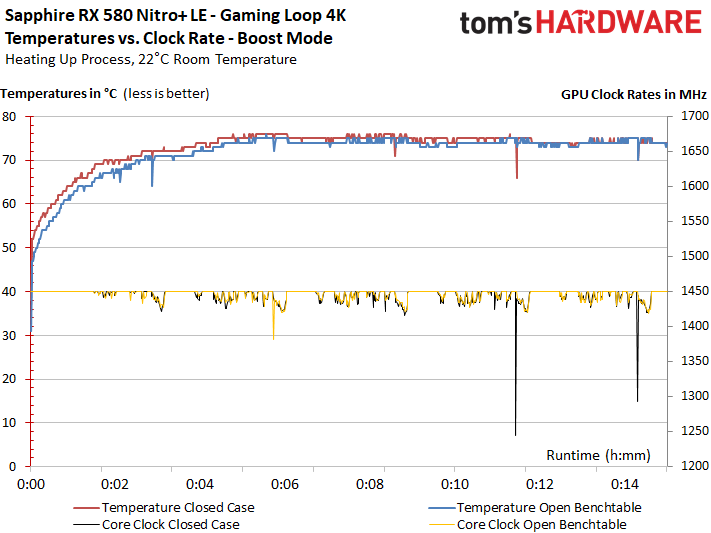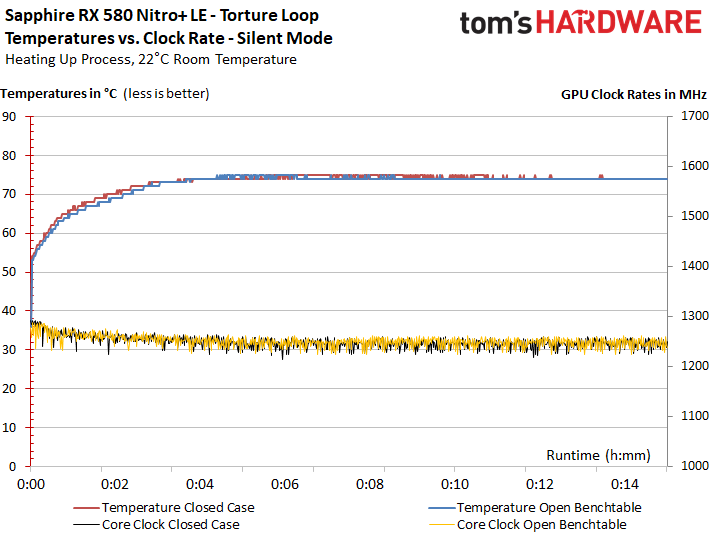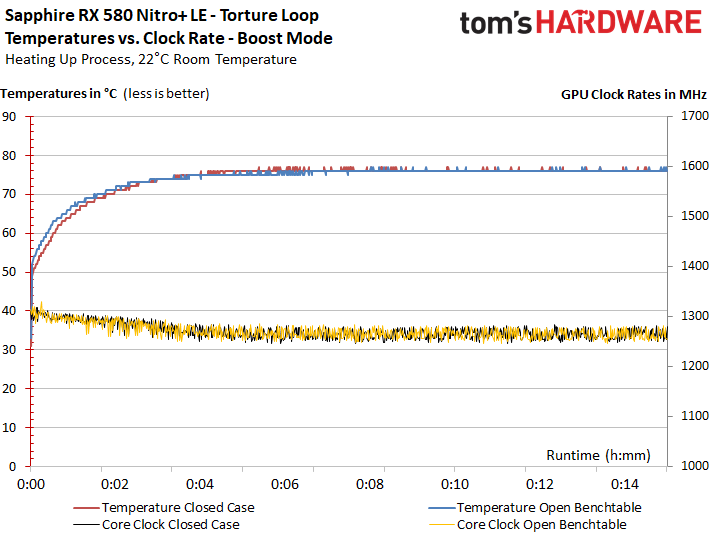AMD Radeon RX 580 8GB Review
Why you can trust Tom's Hardware
Temperatures and GPU Frequencies
Gaming Temperatures and Clock Frequencies
We start with our gaming loop, comparing Sapphire's silent and boost modes. In the two graphs below, temperatures and clock rates are recorded on an open bench table and inside of a closed PC case. The fact that there's really no difference in temperature shows the cooler keeping up with what we're asking from it.
The GPU frequency in silent mode is up to 1411 MHz, whereas boost mode achieves 1450 MHz. Neither setting is consistent throughout our test period, but they get close.
The Nitro+ Radeon RX 580 Limited Edition's 1450 MHz boost mode does represent a fairly rigid overclocking ceiling for this GPU, though. We have to assume we're already working with a hand-selected processor, and manually overclocking it beyond the boost clock rate is practically impossible. Pushing any higher simply results in the frequency dropping more often.
The most we were able to get out of Sapphire's golden sample was 1475 MHz. That's not much of an increase, and the subsequent pull-backs brought the average down to 1450 MHz. In short, manual overclocking is almost completely pointless. And we don't have anything nicer to say about our efforts with the memory.
Still, we observed temperatures between 74 to 76°C on our open bench table and closed case, and those are solid figures.
Stress Test Temperatures and Clock Frequencies
An even more taxing stress test challenges Sapphire's cooling solution more than any real-world workload. And the result is a drop in clock rate that erodes all of the boost mode's advantage. It doesn’t matter which BIOS setting you pick or if you run the card on an open bench; the result is the same.
Using Sapphire's overclocked settings, the cooler reaches its limit. Its fans spin noticeably faster and yet the temperature still ends up a tad higher at 76°C. We even see 78°C briefly.
Get Tom's Hardware's best news and in-depth reviews, straight to your inbox.
GPU temperatures only tell part of the story, though. We also need to take measurements across the rest of the board.
Board Temperatures
Because Sapphire's backplate plays an active role in cooling, we didn't remove it from the Nitro+ Radeon RX 580 Limited Edition. Luckily for us, Sapphire provides gaps in the metal right where we need to point our infrared equipment, saving us from drilling holes.
Gaming Temperatures in Silent Mode and Boost Mode
Temperatures corresponding to both of the board's operating modes are shown below. You'll find two infrared thermal pictures each: the left one reflects performance on an open bench table and the right one is in a closed PC case.
The GPU package's temperature is much higher than what the integrated diode would have us believe. That heat comes from the PCB and its metal layers.
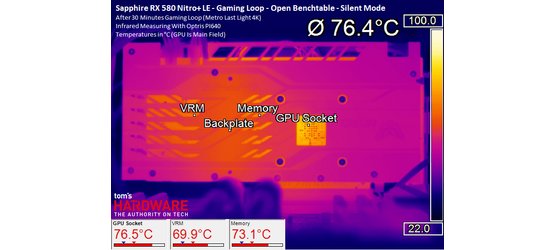
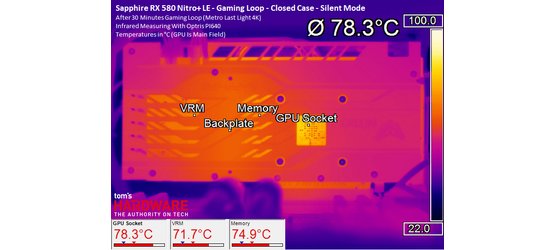
In boost mode, the GPU and its package get at least as hot as before, while all of the other components remain a lot cooler. You see, they benefit from the faster-spinning fan and its increased airflow (even if the consequence is more noise).
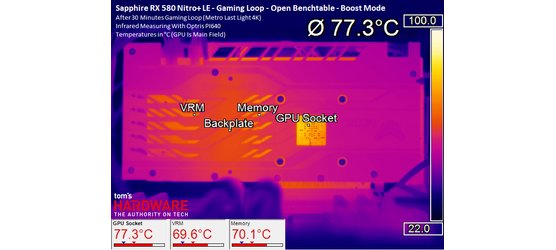
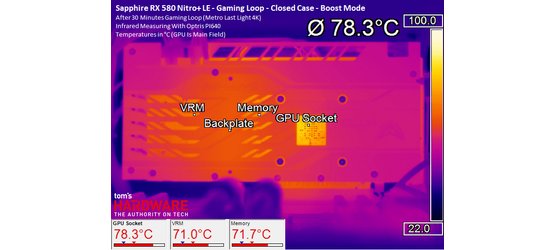
Stress Test Temperatures in Silent Mode and Boost Mode
We push the Nitro+ Radeon RX 580 Limited Edition's cooler to its limit once again with a stress test. Sapphire’s marketing material touts the thermal solution's ability to cope with up to 300W, and our loop provides a respectable 240W. This is just about as far as the GPU can go, yielding an effective worst-case scenario.
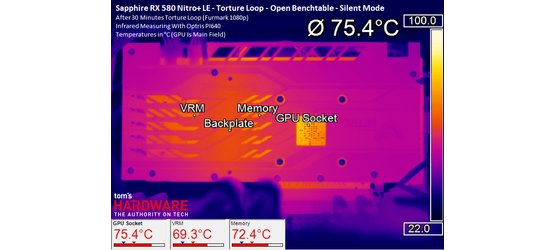

In boost mode, the load is consistently more debilitating, yet the fans don't speed up as much as they did in silent mode. As a result, we measure higher temperatures in several places across the board. Still, our readings are perfectly acceptable.
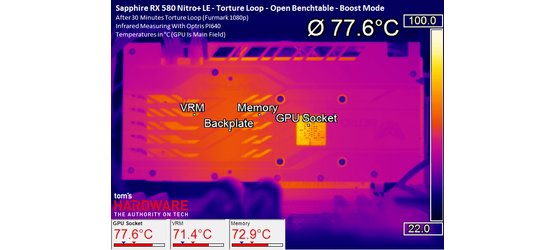
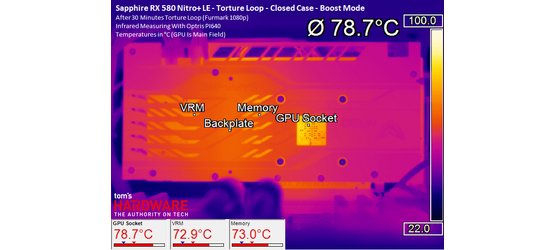
Sapphire's cooler does its job well and may even offer a bit of thermal headroom. Kudos to the company for arming this generation's Nitro+ card with a clear step up from its predecessor.
MORE: Best Graphics Cards
MORE: Desktop GPU Performance Hierarchy Table
MORE: All Graphics Content
Current page: Temperatures and GPU Frequencies
Prev Page Power Consumption Next Page Fan Speed and Noise
Igor Wallossek wrote a wide variety of hardware articles for Tom's Hardware, with a strong focus on technical analysis and in-depth reviews. His contributions have spanned a broad spectrum of PC components, including GPUs, CPUs, workstations, and PC builds. His insightful articles provide readers with detailed knowledge to make informed decisions in the ever-evolving tech landscape
-
max0x7ba Battlefield 1 2560x1440, Ultra benchmark Radeon RX 580 minimum fps does not look right.Reply -
lasik124 Unless I am really missing something, can't you just slightly overclock the 480 to match the slight performance boost the 580 has?Reply -
FormatC Reply
Take a look at the frametimes at start. I think, it's a driver issue, because it was reproducible ;)19579183 said:Battlefield 1 2560x1440, Ultra benchmark Radeon RX 580 minimum fps does not look right.
No, it were in each case less than 1375 MHz. Slower as the Silent Mode of this 580 and simply too hot for my taste. The problem is not the pre-defined clock rate itself but the reduced real clocks from power tune due temps and voltage/power limtations;)19579237 said:Unless I am really missing something, can't you just slightly overclock the 480 to match the slight performance boost the 580 has?
-
lasik124 Reply19579253 said:
Take a look at the frametimes at start. I think, it's a driver issue, because it was reproducible ;)19579183 said:Battlefield 1 2560x1440, Ultra benchmark Radeon RX 580 minimum fps does not look right.
No, it were in each case less than 1375 MHz. Slower as the Silent Mode of this 580 and simply too hot for my taste. The problem is not the pre-defined clock rate itself but the reduced real clocks from power tune due temps and voltage/power limtations;)19579237 said:Unless I am really missing something, can't you just slightly overclock the 480 to match the slight performance boost the 580 has?
So i guess what Im trying to ask is it worth buying at 580 (Currently at a 7870) or save a couple bucks pick up a 480 non reference cooler and be able to slightly overclock it to get in game benchmarks similar if closely identical to the current 580?
-
Math Geek no, you'll get the 480 numbers with a 480. the tested card was already oc'ed and you won't get any better manually. the changes made to the 580 can't be done to the 480.Reply
want the extra few fps, then you'll want to get a 580. -
Tech_TTT I dont get it , for sure AMD could release this card as the original RX 480 long ago , why did they allow Nvidia GTX 1060 to steal the RX 480 share ?Reply
Very Stupid Strategy ... I now alot of people who bought GTX 1060 and wished AMD were better Just to take advantage of the cheaper Freesync Monitors.
AMD you lost millions of buyers !!! for nothing !!! -
turkey3_scratch Reply19579402 said:I dont get it , for sure AMD could release this card as the original RX 480 long ago , why did they allow Nvidia GTX 1060 to steal the RX 480 share ?
Very Stupid Strategy ... I now alot of people who bought GTX 1060 and wished AMD were better Just to take advantage of the cheaper Freesync Monitors.
AMD you lost millions of buyers !!! for nothing !!!
Don't think it's as simple as you make it out to be. They're a huge company with a ton of professionals, they know what they're doing. -
madmatt30 Reply
.19579402 said:I dont get it , for sure AMD could release this card as the original RX 480 long ago , why did they allow Nvidia GTX 1060 to steal the RX 480 share ?
Very Stupid Strategy ... I now alot of people who bought GTX 1060 and wished AMD were better Just to take advantage of the cheaper Freesync Monitors.
AMD you lost millions of buyers !!! for nothing !!!
Better binning ,refinements on the power circuitry - something thats come with time after the initial production runs of the rx470/480.
Fairly normal process for how amd work in all honesty.
Has it lost them some custom to prospective buyers in the last 6 months since the rx series was released ?? Maybe a few - not even 1% of the buyers they'd have lost if theyd actually held the rx series release back until now though!!
-
Tech_TTT Reply19579428 said:
.19579402 said:I dont get it , for sure AMD could release this card as the original RX 480 long ago , why did they allow Nvidia GTX 1060 to steal the RX 480 share ?
Very Stupid Strategy ... I now alot of people who bought GTX 1060 and wished AMD were better Just to take advantage of the cheaper Freesync Monitors.
AMD you lost millions of buyers !!! for nothing !!!
Better binning ,refinements on the power circuitry - something thats come with time after the initial production runs of the rx470/480.
Fairly normal process for how amd work in all honesty.
Has it lost them some custom to prospective buyers in the last 6 months since the rx series was released ?? Maybe a few - not even 1% of the buyers they'd have lost if theyd actually held the rx series release back until now though!!
Thats the Job of the R&D in the beta testing interval .. not after release, I am not buying this explanation at all.

